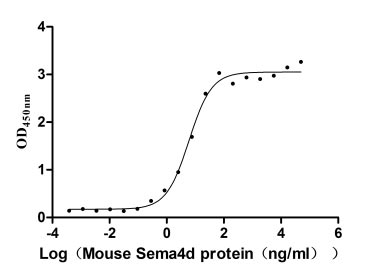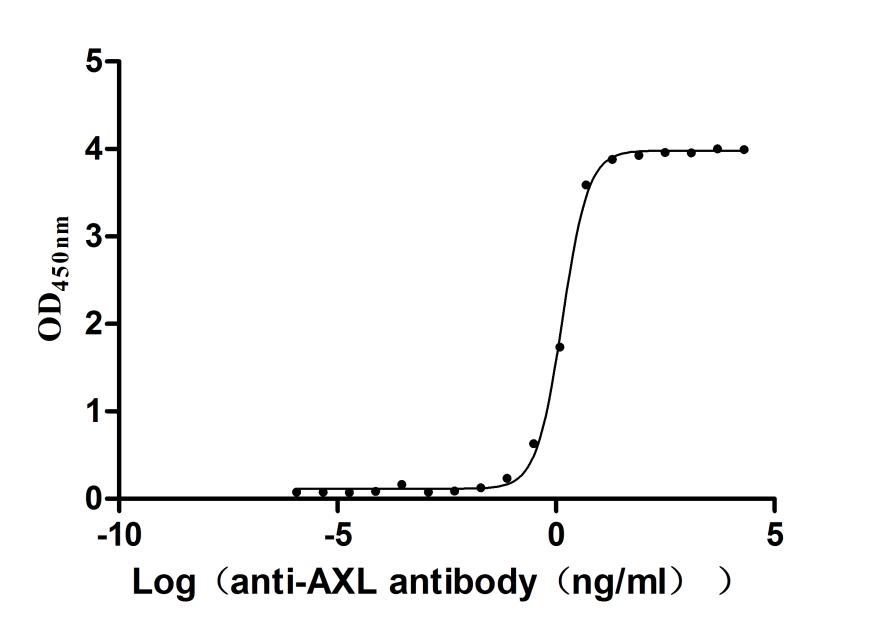Recombinant Human Cytochrome P450 4Z1 (CYP4Z1), partial
-
货号:CSB-YP771452HU
-
规格:
-
来源:Yeast
-
其他:
-
货号:CSB-EP771452HU
-
规格:
-
来源:E.coli
-
其他:
-
货号:CSB-EP771452HU-B
-
规格:
-
来源:E.coli
-
共轭:Avi-tag Biotinylated
E. coli biotin ligase (BirA) is highly specific in covalently attaching biotin to the 15 amino acid AviTag peptide. This recombinant protein was biotinylated in vivo by AviTag-BirA technology, which method is BriA catalyzes amide linkage between the biotin and the specific lysine of the AviTag.
-
其他:
-
货号:CSB-BP771452HU
-
规格:
-
来源:Baculovirus
-
其他:
-
货号:CSB-MP771452HU
-
规格:
-
来源:Mammalian cell
-
其他:
产品详情
-
纯度:>85% (SDS-PAGE)
-
基因名:CYP4Z1
-
Uniprot No.:
-
别名:CYP4Z1; UNQ3060/PRO9882Cytochrome P450 4Z1; EC 1.14.14.1; CYPIVZ1
-
种属:Homo sapiens (Human)
-
蛋白长度:Partial
-
蛋白标签:Tag type will be determined during the manufacturing process.
The tag type will be determined during production process. If you have specified tag type, please tell us and we will develop the specified tag preferentially. -
产品提供形式:Lyophilized powder
Note: We will preferentially ship the format that we have in stock, however, if you have any special requirement for the format, please remark your requirement when placing the order, we will prepare according to your demand. -
复溶:We recommend that this vial be briefly centrifuged prior to opening to bring the contents to the bottom. Please reconstitute protein in deionized sterile water to a concentration of 0.1-1.0 mg/mL.We recommend to add 5-50% of glycerol (final concentration) and aliquot for long-term storage at -20℃/-80℃. Our default final concentration of glycerol is 50%. Customers could use it as reference.
-
储存条件:Store at -20°C/-80°C upon receipt, aliquoting is necessary for mutiple use. Avoid repeated freeze-thaw cycles.
-
保质期:The shelf life is related to many factors, storage state, buffer ingredients, storage temperature and the stability of the protein itself.
Generally, the shelf life of liquid form is 6 months at -20°C/-80°C. The shelf life of lyophilized form is 12 months at -20°C/-80°C. -
货期:Delivery time may differ from different purchasing way or location, please kindly consult your local distributors for specific delivery time.Note: All of our proteins are default shipped with normal blue ice packs, if you request to ship with dry ice, please communicate with us in advance and extra fees will be charged.
-
注意事项:Repeated freezing and thawing is not recommended. Store working aliquots at 4°C for up to one week.
-
Datasheet :Please contact us to get it.
相关产品
靶点详情
-
功能:A cytochrome P450 monooxygenase that catalyzes the in-chain oxidation of fatty acids. Catalyzes the hydroxylation of carbon-hydrogen bonds. Hydroxylates lauric and myristic acids predominantly at the omega-4 and omega-2 positions, respectively. Catalyzes the epoxidation of double bonds of polyunsaturated fatty acids (PUFA). Displays an absolute stereoselectivity in the epoxidation of arachidonic acid producing the 14(S),15(R)-epoxyeicosatrienoic acid (EET) enantiomer. Mechanistically, uses molecular oxygen inserting one oxygen atom into a substrate, and reducing the second into a water molecule, with two electrons provided by NADPH via cytochrome P450 reductase (CPR; NADPH-ferrihemoprotein reductase).
-
基因功能参考文献:
- If CYP4Z1 has a role to play in modulating cancer progression, new data form yeast microsomes expressing recombinant human enzyme suggest that the mechanism does not involve direct 20-HETE generation by this enzyme. PMID: 29018033
- This study reports on the creation of a new homology model of CYP4Z1 and performed molecular docking experiments, which indicate that all active substrates show a highly similar binding geometry compared to the endogenous substrates. PMID: 28951277
- CYP4Z1 3'UTR could inhibit the migration and Epithelial-mesenchymal transition of breast cancer cells. PMID: 27520371
- CYP4Z1 and CYP4Z2P were downregulated in MCF-7 cells compared with tamoxifen-resistant MCF-7-TamR cells PMID: 26980484
- CYP4Z1 overexpression promotes tumor angiogenesis and growth in breast cancer partly via PI3K/Akt and ERK1/2 activation PMID: 22841774
- Human cytochrome P450 (CYP), termed CYP4Z1,was identified, and the cDNA was cloned from a breast carcinoma line . PMID: 15059886
- PPARalpha has a role in CYP4X1 regulation, and the glucocorticoid and progesterone receptors have roles in CYP4Z1 gene activation PMID: 15797250
- CYP4Z1-dependent in-chain hydroxylation of lauric and myristic acid, which in both cases leads to the formation of four different monohydroxylated products at positions omega-2, omega-3, omega-4, and omega-5, respectively PMID: 19090726
显示更多
收起更多
-
亚细胞定位:Endoplasmic reticulum membrane; Single-pass type II membrane protein. Microsome membrane; Single-pass type II membrane protein.
-
蛋白家族:Cytochrome P450 family
-
组织特异性:Preferentially detected in breast carcinoma tissue and mammary gland, whereas only marginal expression is found in all other tested tissues.
-
数据库链接:
HGNC: 20583
KEGG: hsa:199974
STRING: 9606.ENSP00000334246
UniGene: Hs.176588
Most popular with customers
-
Recombinant Mouse Semaphorin-4D (Sema4d), partial (Active)
Express system: Mammalian cell
Species: Mus musculus (Mouse)
-
Recombinant Human Poliovirus receptor (PVR) (I340M), partial (Active)
Express system: Mammalian cell
Species: Homo sapiens (Human)
-
Recombinant Rat Intestinal-type alkaline phosphatase 1 (Alpi) (Active)
Express system: Mammalian cell
Species: Rattus norvegicus (Rat)
-
Recombinant Human Cannabinoid receptor 1 (CNR1)-VLPs (Active)
Express system: Mammalian cell
Species: Homo sapiens (Human)
-
Recombinant Macaca fascicularis CD93 molecule (CD93), partial (Active)
Express system: Mammalian cell
Species: Macaca fascicularis (Crab-eating macaque) (Cynomolgus monkey)
-
Recombinant Human Cell adhesion molecule 1 (CADM1), partial (Active)
Express system: Mammalian cell
Species: Homo sapiens (Human)
-
Recombinant Human Transmembrane 4 L6 family member 1(TM4SF1)-VLPs (Active)
Express system: Mammalian cell
Species: Homo sapiens (Human)
-
Recombinant Human Tyrosine-protein kinase receptor UFO(AXL),partial (Active)
Express system: Mammalian cell
Species: Homo sapiens (Human)



-AC1.jpg)
















